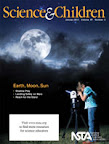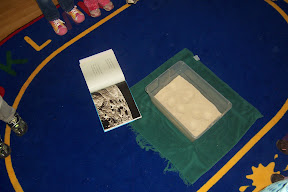Moon and the Earth and the Sun, and more
By Peggy Ashbrook
Posted on 2012-01-06
Happy New Year! This year I look forward to more conversation in the early childhood community about science education.
 The January 2012 Early Years column adapts an activity about making craters from Marie Faust Evitt’s book, Thinking BIG, Learning BIG.
The January 2012 Early Years column adapts an activity about making craters from Marie Faust Evitt’s book, Thinking BIG, Learning BIG.  Craters on the Moon are visible without a telescope, even in daytime, a time when teachers can point out the Moon to their students. Children enjoy making craters in snow, damp sand, or other fine material, by dropping balls of varying sizes and weights into the material. There are many ways to use imaginative play to allow children to explore the topic of Space, and the ideas they have already learned through media and at home. Some of what we learn as children (Think of “The cow jumped over the Moon”) may lead to misconceptions that, if teachers learn of them through conversation, we can help students replace with accurate information. Simply talking about the accurate information will not correct misconceptions, but through activities and discussion students can discard them.
Craters on the Moon are visible without a telescope, even in daytime, a time when teachers can point out the Moon to their students. Children enjoy making craters in snow, damp sand, or other fine material, by dropping balls of varying sizes and weights into the material. There are many ways to use imaginative play to allow children to explore the topic of Space, and the ideas they have already learned through media and at home. Some of what we learn as children (Think of “The cow jumped over the Moon”) may lead to misconceptions that, if teachers learn of them through conversation, we can help students replace with accurate information. Simply talking about the accurate information will not correct misconceptions, but through activities and discussion students can discard them.
Learn more about the Moon and its relationship to the Earth and Sun by using some of the resources in the National Science Teachers Association’s Learning Center such as the a collection of resources I created titled “Moon and sky—observations.” Register at no cost, go to Advanced Search and enter Keyword: Moon, Author: Ashbrook, and Type of Learning Resource: User created collections (select in both menus) to see resources in the “Moon and sky—observations” collection. Photos of features of the Moon can be viewed on GeologyRocks site by Dr. Katie Davis and Dr. Jon Hill.
Young children may know the word “gravity” but we don’t expect them to understand yet that it is a force between any two objects and that it pulls the objects together. In the case of the Earth and the objects on it, the gravitational pull of the Earth on the objects is greatest, so objects are pulled down to the Earth (ground). The January 2012 Teaching Through Tradebooks column, “Gravity and Weight”, by Emily Morgan and Karen Ansberry uses the 5E Learning Cycle in activities for grades K-2 and 3-5. These authors are sometimes referred to affectionately as “The Picture-Perfect ladies” because their “Picture-Perfect Science” books are very helpful to elementary teachers (note that the picture trade books they suggest are available through NSTA).
The article “Shadow Play” by Kathy Cabe-Trundle and Margilee P. Hilson is free to all—read about how students can observe shadows to learn about seasonal change. I recommend reading it (even if some of the activities are too advanced for your class) to see the authors’ approach to teaching concepts about which students commonly have misconceptions. I find the articles for older students a useful review of concepts at an elementary level, for myself.
Let me know what your plans are for the New Year, and what you’d like to see discussed on this Early Years blog by commenting below. Best wishes for the new year,
Peggy
Disclaimer: The views expressed in this blog post are those of the author(s) and do not necessarily reflect the official position of the National Science Teaching Association (NSTA).


